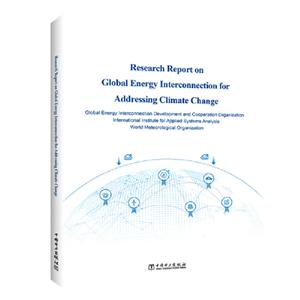全球能源互联网应对气候变化研究报告(英文版)
本书特色
[
The Report consists of seven chapters. Chapter 1 describes the scientific facts and impacts of climate change and analyzes its status quo and actions as well as the key role of energy transition in addressing it. Climate service for energy is needed to support the transition to clean energy. This chapter is jointly written by WMO and GEIDCO. Chapter 2 explains the framework and theory of GEI mitigation and puts forward its mechanisms and pathways. Chapter 3 deals with the quantitative analysis of the characteristics and mitigation value of the GEI system by using a comprehensive assessment modelling framework in conjunction with energy system and power system optimization models. Chapter 4 focuses on the GEI mitigation technology portfolio, as well as the development trend and combined use of such technologies as clean replacement, electricity replacement, grid interconnection, energy efficiency enhancement, and carbon removal. Chapter 3 and 4 are jointly written by IIASA and GEIDCO. Chapter 5 studies and proposes key mitigation actions through energy interconnection in different continents based on their respective conditions of climate, resource endowment, and energy and power development. Chapter 6 analyzes the contribution of GEI to economy, society, climate, environment, health and sustainable development. Chapter 7 suggests some innovative mechanisms for addressing climate change, including linking mitigation targets with integrated policy instruments, mobilizing finance resources through the electricity-carbon market, accelerating major projects’ implementation by an innovative mode of “electricity, mining, metallurgy, industry and trade” and adopting new approaches for universal power access to enhance climate resilience.The Report consists of seven chapters. Chapter 1 describes the scientific facts and impacts of climate change and analyzes its status quo and actions as well as the key role of energy transition in addressing it. Climate service for energy is needed to support the transition to clean energy. This chapter is jointly written by WMO and GEIDCO. Chapter 2 explains the framework and theory of GEI mitigation and puts forward its mechanisms and pathways. Chapter 3 deals with the quantitative analysis of the characteristics and mitigation value of the GEI system by using a comprehensive assessment modelling framework in conjunction with energy system and power system optimization models. Chapter 4 focuses on the GEI mitigation technology portfolio, as well as the development trend and combined use of such technologies as clean replacement, electricity replacement, grid interconnection, energy efficiency enhancement, and carbon removal. Chapter 3 and 4 are jointly written by IIASA and GEIDCO. Chapter 5 studies and proposes key mitigation actions through energy interconnection in different continents based on their respective conditions of climate, resource endowment, and energy and power development. Chapter 6 analyzes the contribution of GEI to economy, society, climate, environment, health and sustainable development. Chapter 7 suggests some innovative mechanisms for addressing climate change, including linking mitigation targets with integrated policy instruments, mobilizing finance resources through the electricity-carbon market, accelerating major projects’ implementation by an innovative mode of “electricity, mining, metallurgy, industry and trade” and adopting new approaches for universal power access to enhance climate resilience.
]
内容简介
[
The Report consists of seven chapters. Chapter 1 describes the scientific facts and impacts of climate change and analyzes its status quo and actions as well as the key role of energy transition in addressing it. Climate service for energy is needed to support the transition to clean energy. This chapter is jointly written by WMO and GEIDCO. Chapter 2 explains the framework and theory of GEI mitigation and puts forward its mechanisms and pathways. Chapter 3 deals with the quantitative analysis of the characteristics and mitigation value of the GEI system by using a comprehensive assessment modelling framework in conjunction with energy system and power system optimization models. Chapter 4 focuses on the GEI mitigation technology portfolio, as well as the development trend and combined use of such technologies as clean replacement, electricity replacement, grid interconnection, energy efficiency enhancement, and carbon removal. Chapter 3 and 4 are jointly written by IIASA and GEIDCO. Chapter 5 studies and proposes key mitigation actions through energy interconnection in different continents based on their respective conditions of climate, resource endowment, and energy and power development. Chapter 6 analyzes the contribution of GEI to economy, society, climate, environment, health and sustainable development. Chapter 7 suggests some innovative mechanisms for addressing climate change, including linking mitigation targets with integrated policy instruments, mobilizing finance resources through the electricity-carbon market, accelerating major projects’ implementation by an innovative mode of “electricity, mining, metallurgy, industry and trade” and adopting new approaches for universal power access to enhance climate resilience.
]
作者简介
[
全球能源互联网发展合作组织,是由致力于推动世界能源可持续发展的相关企业、组织、机构和个人等自愿组成的国际组织。注册地设在北京。合作组织的宗旨是推动构建全球能源互联网,以清洁和绿色方式满足全球电力需求,推动实现联合国“人人享有可持续能源”和应对气候变化目标,服务人类社会可持续发展。
]
封面

书名:全球能源互联网应对气候变化研究报告(英文版)
作者:GlobalEnergyIntercon
页数:179
定价:¥170.0
出版社:中国电力出版社
出版日期:2019-12-01
ISBN:9787519832223
PDF电子书大小:157MB 高清扫描完整版
